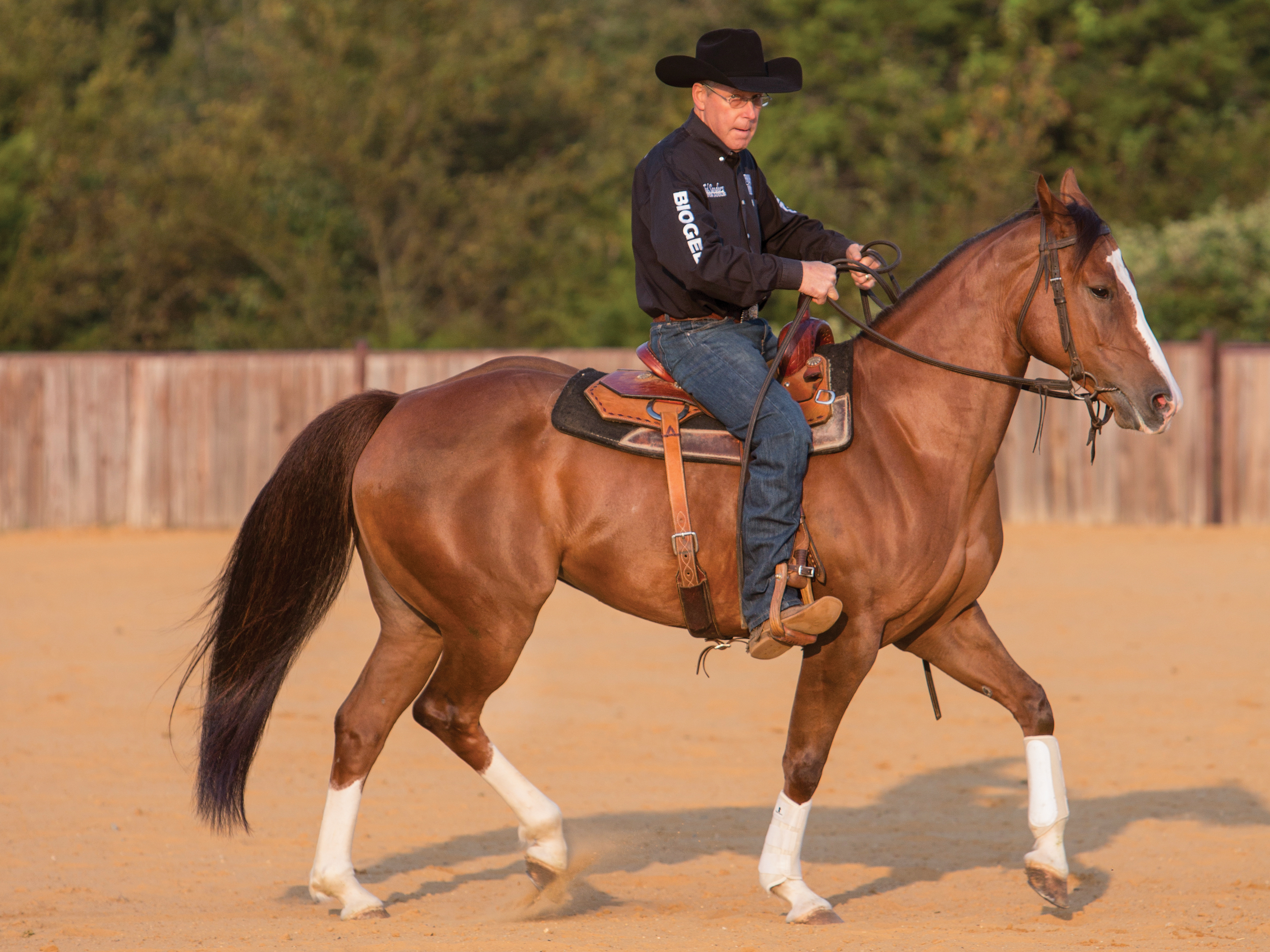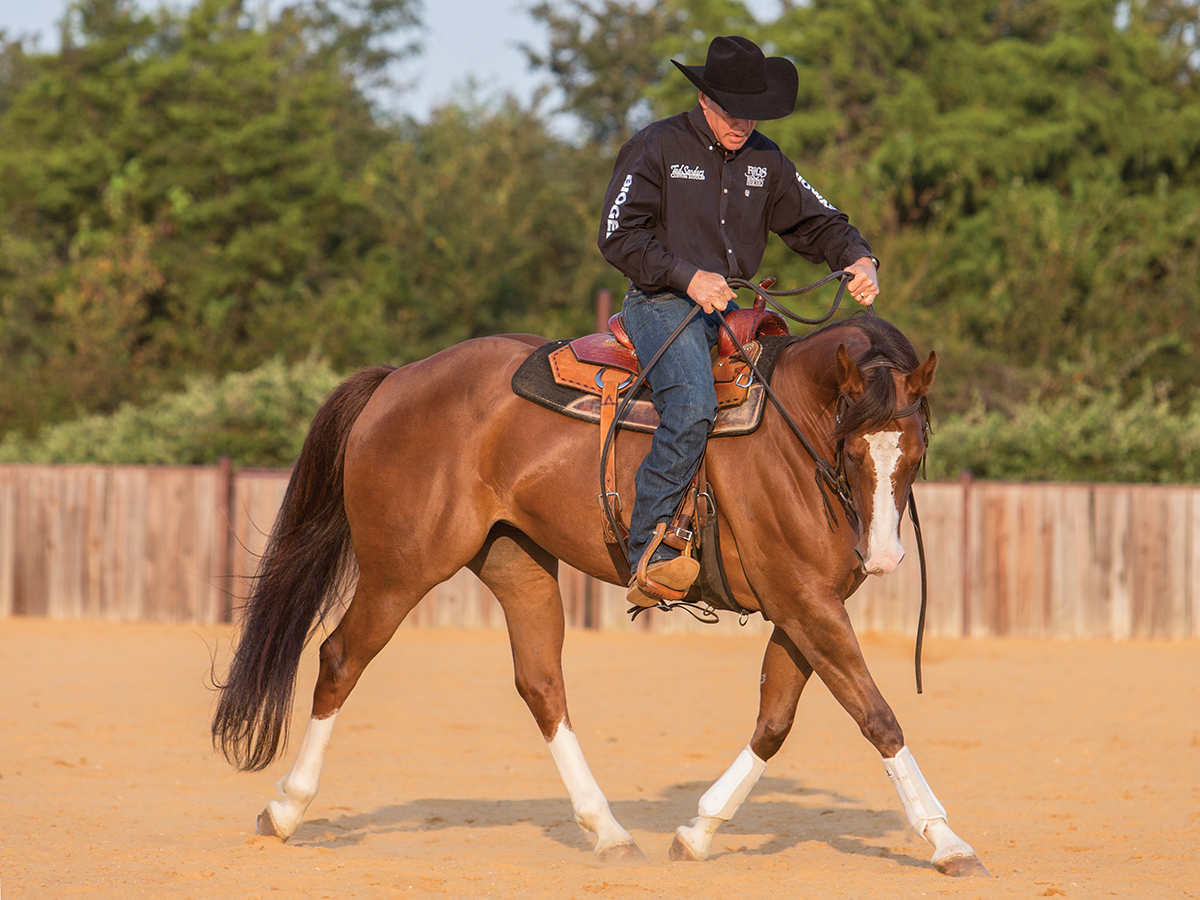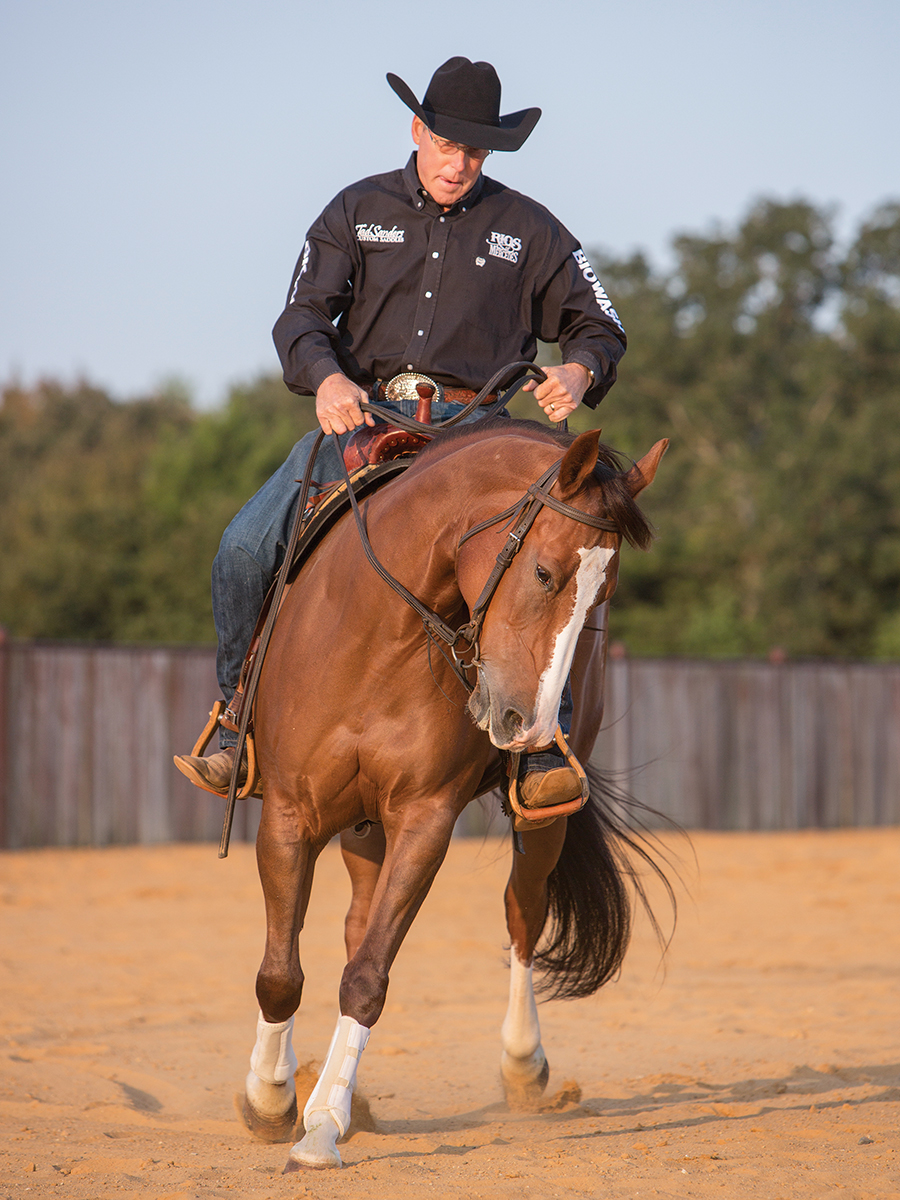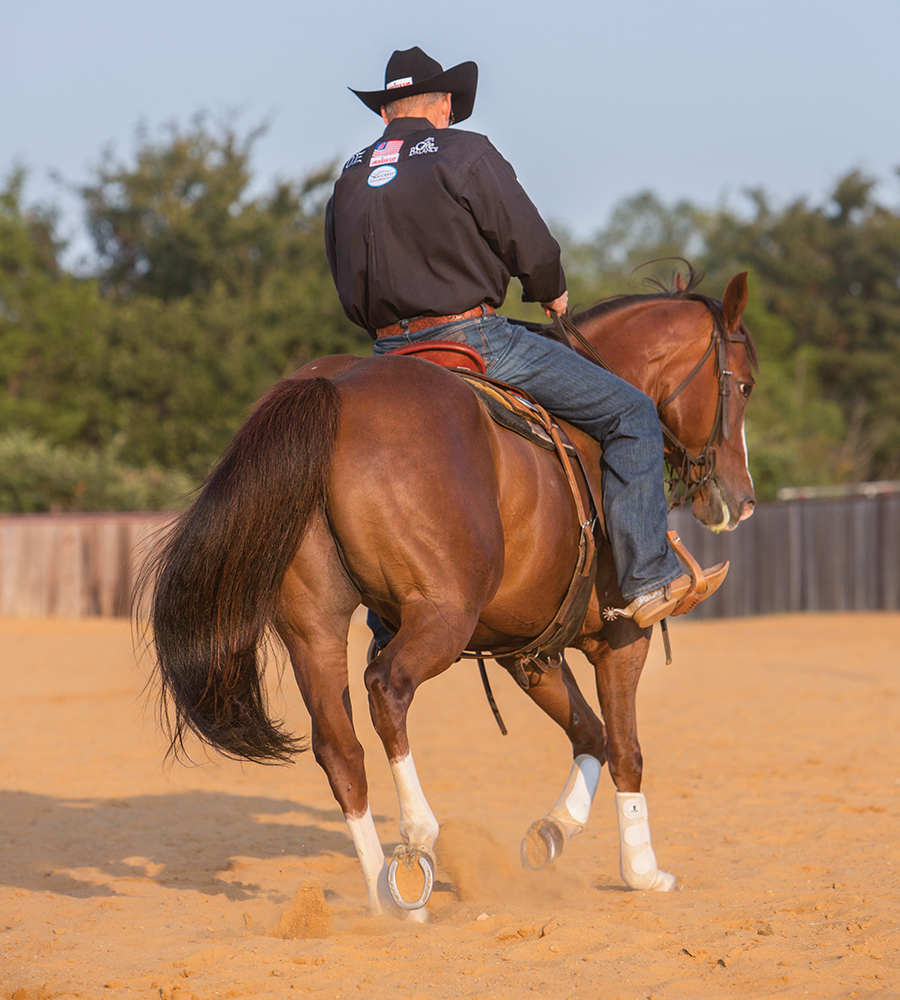Many horses move with their head up and back hollow, causing an up-and-down motion that makes them look like they’re “climbing” instead of traveling forward. This undesirable trait can be caused by poor conformation or the horse not knowing how to use his body.
[Read More On: Conformation]

Through exercises that create willing, freely forward motion that raises the back, lowers the neck, and softens the horse’s chin, you can improve a horse’s forward motion and “level him out.” This is especially helpful with barrel horses, as demonstrated here, because with proper movement, your horse can turn a barrel smoother, which impacts your overall time.
[Read More On: Improving Barrel Racing Time]
Identify the Issue
Watching a horse in the warm-up pen or when he’s on pattern, it’s fairly easy for me to identify a horse that could move better and make a faster run. You might be so used to how your horse feels, you might not understand your horse isn’t moving effectively and is using too much energy the wrong way.
A “climber” that needs to level out carries his head too high and moves up with his front end instead of forward. When he goes to turn a barrel, his head is up, his back hollows out, and he has a short-strided turn instead of using his hind leg to drive underneath and get around the barrel. There are two factors to consider when judging how and why a horse is moving poorly.

Kate Bradley Byars
First, look at your horse’s conformation without a saddle. Horses built with a long back and a neck that ties in low are more apt to move up instead of stride out and forward. A horse with more mass in his chest and throatlatch is often a climber in movement. It’s not natural for a horse built like this to level his neck out and pick his back up. He wants to be high-headed because it’s more natural, but a lower neck carriage can be taught.
Second, consider your horse’s energy prior to the barrel run. An over-excited horse’s high head is accentuated. You might try to hold your horse back, which just makes his posture more animated than usual. Horses that climb with their heads up may not be bad movers generally, but their actions before a run and around the barrels inhibit proper movement. To correct the upward motion, your horse needs to be taught to level out by learning to drop his neck, lift his shoulder, and round his back.
[Read More On: Calming Your Horse]
FIX THE FOUNDATION
Lowering a horse’s neck is something that can be difficult to teach, but the results are always worth the effort. I use methods that have served me well to teach both cow horses and barrel horses to level out.
Altogether, this makes your horse a better mover and allows him to make smoother barrel turns.
[Read More On: Patterning Your Barrel Horse]

Kate Bradley Byars

Kate Bradley Byars
Correcting your horse’s way of moving isn’t easy, and it’s not done overnight. But it can be done. When your horse’s foundation isn’t solid it can lead to problems like bad movement, such as travelling with a hollow back and not driving forward from the hind leg. Going back to the basics is the answer.
Drive to the Face
When you level out your horse, he’ll also pick up his back. The more he picks up his back, the more his hind leg comes up underneath as it should, which helps keep your horse’s shoulder up. To achieve this, you need good, willing, freely forward motion. I prefer a snaffle bit for this exercise, but if your horse is pushy and strong in the bridle he may not respond to that. Use your best judgement to ride in a bit that’s not severe but allows control of your horse.
First, make contact with your horse’s face through your reins. At the same time, push with your calves to move your horse into a forward walk. It’s not really kicking your horse forward, because you shouldn’t use your spurs unless the horse stops or refuses forward motion. Don’t ride a tight circle or a fixed pattern; ride long lines to drive home good forward motion.
When you pick up your horse’s face and make contact, his chin should drop. If he’s striding forward, his back will round. To start, he’ll feel like he has a short stride. When you achieve drive from behind, you’ll feel your horse pick up his back and have a looser, smoother, forward-moving walk with a bigger stride from behind. Whether in a trot or a walk, the gait feels smoother. Be aware if you’re actually achieving roundness in the back or just walking faster.
Some horses get pushy in the face when you take hold with the reins. Don’t grab up the reins fast and pull your horse’s head to his chest. Close your contact with your reins slowly, and draw the reins to a length that maintains your horse’s lowered head set while engaging his hind end. If your horse isn’t used to contact with his face, he might push against you and not want to move forward. It can take a while to work through, but when he breaks loose, he’ll instantly feel softer. When your horse finally starts to raise his back, his hind strides lengthen and his shoulders come up. He gets softer in the chin. Relax your hands for a few strides when you feel this and give a little rein back to your horse. Then start the process again.
The next step is to achieve this position at the trot. This is something you need to work on every ride so your horse learns to carry himself naturally in a level position.
Circle Up
If your horse doesn’t grasp the concept of driving up from behind in an engaging walk or trot, work in circles and counter-bend circles. This forces him to use his hind end to push forward. To do this, maintain contact with your horse’s face and use your calves to signal him to move forward.

Kate Bradley Byars
If he refuses or balks when you engage his face and ask him to move forward, go out on a big circle with a little arc to your horse’s head and neck. In the arc position—with his nose slightly turned in toward the point of his shoulder—he should be more willing to move forward while you hold pressure on his mouth. If your horse doesn’t understand confinement, that is having his face held while you use your legs, taking the straightness out of his spine from the poll to the tail takes away his power.
Don’t pull your horse’s chin to his chest and over-bridle him; his chin will soften as he understands the exercise and his neck begins to level out. The goal is to eventually ride straight while you drive your horse’s hind leg up and level out his front end, but beginning with your horse bent in a circle can get this exercise started.
Using that circle to arc your horse’s body, you can signal with more outside leg to push his hip underneath him as you drive forward. This rounds your horse’s back and levels the front end. For some horses, this exercise is easier than starting in a straight line.
As your horse begins to understand how to engage his hind end and raise his back, widen the circle and loosen the bent position. Eventually, you’ll be able to ride a straight line with the same control as when his body was arced. Then work on moving your horse’s body parts into different positions. Instead of bending to the inside, counter-arc to the outside on a circle.
To do this, start a circle. As your horse travels, slowly bend his head and neck to the outside. In an ordinary circle to the left, you’d use your inside calf to keep your horse’s body in a good position. But for this counter-bend, use your outside calf to keep your horse moving forward in the counter-arc.
Your horse must raise his back and push through himself to keep his shoulders up. Being able to move your horse in different positions while maintaining good body carriage creates better form and fluidity of movement.

Kate Bradley Byars
CALM AND COLLECTED
Like any athlete that gets hyped up before a competition, barrel horses get excited before a run. Your horse uses precious energy that could be spent running a faster pattern. Get in the habit of walking perfect circles at home—nice and relaxed—then take that habit to the barrel race. Your horse can relax into his routine and remain calm.
The perfect circle is just that, a circle. Learn to walk a circle that is the same size or slightly larger than what gets around a barrel. Keep your horse’s shoulder up and his back raised, much like you’d want when going around a barrel. Doing this is non-invasive and relaxing, especially if it’s a routine used at home that your horse is familiar with doing.

